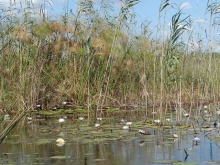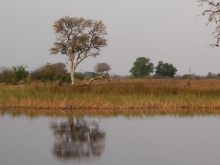The physical landscape
Topographically, the Zambezi Region is particularly flat, forming part of the larger Kalahari Basin. Much of the Basin is filled with sand deposited by wind and this means that the soils are generally poor in nutrients and have low capacity to hold water. Almost the entire Mudumu landscape falls between 900 and 1,000 m above sea level. The area is underlain by Kalahari sediments, mostly unconsolodated sands, clays and calcrete. Below these are much older sedimentary rocks of the Karoo Group suggesting that sedimentaion of the basin has been in progress for over 60 million years.
The Kwando River holds the only permanent water in the landscape while in some areas there are seasonal pans which may hold water after good rains. The Kwando River starts in the central and eastern parts of Angola and flows southward, forming the eastern boundary of Angola with Zambia and further on, the boundary between Botswana and Namibia. The Kwando River (locally known as the Mashi River) floods only in June-July at Kongola, resulting in the filling of the Linyanti River to the east three months later. River flow is slow due to the flast topography and large expanses of reeds and marshes. The Kwando River has a broad floodplain 2 - 5 km wide with numerous backwaters and oxbow lakes which are home to plenty of hippo and crocodiles and a rangeof wetland wildlife not found elsewhere in Namibia.
The major land types within the Mudumu landscape are:
• The Kwando river and its channels that make up areas of open water.
• The associated floodplains - such as in Nkasa Rupara National Park - which form flat areas dominated by grasslands and old river channels. River waters flood these areas when good rains in the catchment areas cause river levels to rise.
• Riverine woodlands of the Kwando river valley, characterised by a high diversity of tall trees.
• Mopane woodlands lie in areas of old drainage lines which are being covered by wind-blown sand deposits - Mudumu National Park, Balyerwa, Wuparo and Dzoti Conservancies.
• Kalahari woodlands which include much of Kwandu, Mayuni, Mashi and Sobbe Conservancies.





